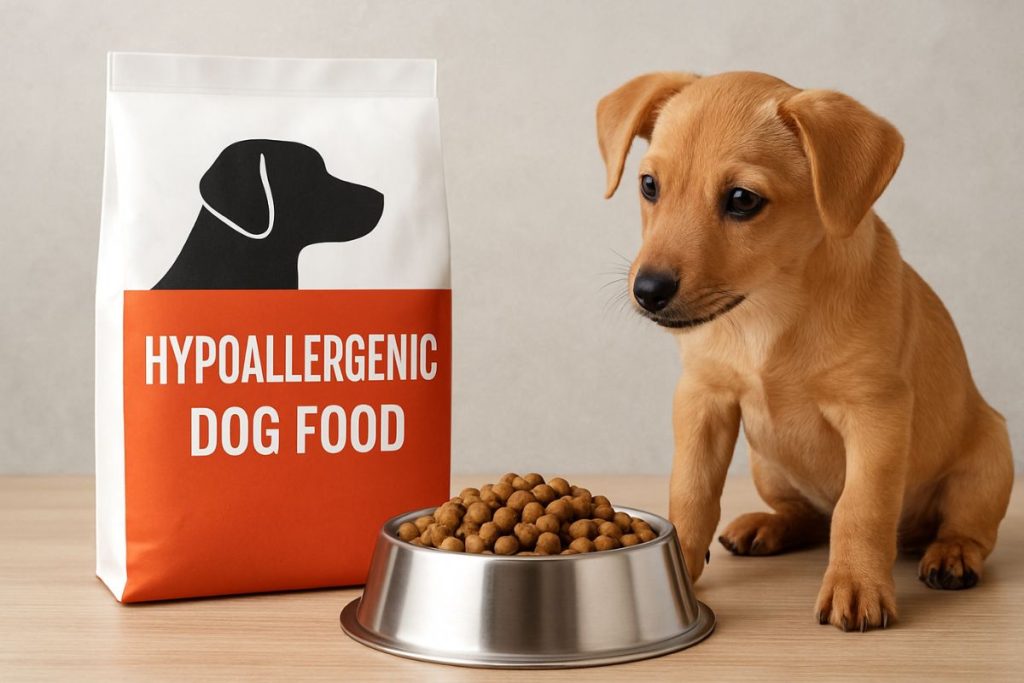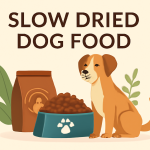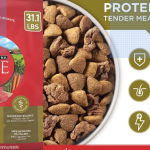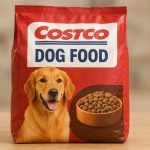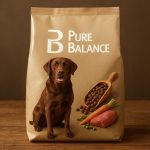Meta Title: Best Dog Food for Allergies: Hypoallergenic Diet Guide
Meta Description: Find relief for your sensitive dog with the best dog food for allergies. Learn about hypoallergenic diets, ingredient selection, and tips to ease itching.
Best Dog Food for Allergies: Hypoallergenic Diet Guide
Many dogs suffer from itchy skin, frequent ear infections, or upset stomachs, leading owners to suspect a food allergy. For these pets, choosing the best dog food for allergies is essential to relief and comfort. True food allergies are actually quite rare – one Banfield study found only about 0.2% of dogs have a true food allergyavma.org – but for affected dogs the impact can be severe. Hypoallergenic dog foods are specially formulated to minimize or eliminate common triggers, helping sensitive pups feel better quickly. These diets use limited, high-quality ingredients and novel proteins (like duck or venison) that are less likely to cause reactionsapupabove.comapupabove.com. By removing usual suspects (beef, chicken, wheat, soy, dairy, etc.), a hypoallergenic formula can significantly reduce itching, scratching, and digestive upset. In fact, experts note that such specialized diets can be a “game-changer” for allergic dogs, offering relief from symptoms and promoting overall well-beingapupabove.comapupabove.com.
A domestic dog enjoys a hypoallergenic meal from a white bowl. Hypoallergenic dog foods typically feature one novel protein (e.g. lamb, duck or venison) and a single, gentle carbohydrate source. By avoiding common allergens like beef, chicken, wheat, corn, soy, dairy, and eggsthesprucepets.comaspca.org, these diets reduce immune triggers and digestive irritants. For example, a reputable hypoallergenic formula might use duck and sweet potato instead of chicken and corn. Over time, feeding such a diet can greatly improve a sensitive dog’s health: studies show hypoallergenic diets “can significantly improve a dog’s quality of life” by reducing exposure to irritantsapupabove.com, and many pets experience fewer skin problems and firmer stools within a few weeks.
What Causes Dog Food Allergies?
Food allergies in dogs occur when the immune system overreacts to a particular ingredient in the diet. Technically, the allergen is always a protein. When a susceptible dog eats that protein, its body treats it like a threat, triggering inflammation and itchingaspca.org. Common allergy culprits tend to be proteins that dogs eat often. In fact, veterinary sources report that “most common food allergens come from beef, dairy, and chicken” in dogspurinainstitute.com. Other frequently problematic ingredients include lamb, wheat/gluten, corn, soy, and eggsthesprucepets.comaspca.org. Even a food the dog has tolerated for years can suddenly become an allergen.
Food intolerances (non-immune reactions) can cause similar symptoms, but they differ biologically. For instance, lactose intolerance is an enzyme deficiency, not an immune allergypurinainstitute.com. In practice, however, the symptoms of intolerance and allergy overlap, so management is often similar (elimination diet and hypoallergenic food). If other causes (like fleas or infections) are ruled out, vets typically diagnose a food allergy via an elimination trial: feeding a simple, novel-protein diet for 6–12 weeks to see if symptoms clearfrontiersin.orgaspca.org. This process is the gold standard to identify the offending ingredient and confirm a true food allergy.
Common allergen sources in dog food include:
- Beef and Chicken: The most frequent protein allergens in many dietsthesprucepets.com.
- Lamb and Pork: Sometimes used as alternative proteins, but some dogs can react to them as well.
- Wheat/Gluten: Grains like wheat can trigger allergies or intolerances in sensitive dogs.
- Dairy and Eggs: Milk proteins and eggs are common allergensaspca.org.
- Soy and Corn: Fillers like soy and corn can irritate sensitive stomachs.
Always tell your vet about symptoms like intense scratching or gastrointestinal upset so they can guide testing or dietary trials.
Signs of Food Allergies in Dogs
Food allergies most often cause skin and gastrointestinal (GI) symptoms. Typical signs include:
- Itchy Skin & Rashes: Dogs may develop persistent itching, redness, hot spots, or scabs on the body. Allergic itching often affects the face, ears, paws, belly and rear endthesprucepets.com.
- Hair Loss and Chewing: Constant licking/chewing of feet or body can lead to hair loss or chronic skin irritation.
- Chronic Ear Infections: Recurring otitis externa (ear inflammation/infection) is a common clue. Dogs with food allergies often have inflamed, waxy, or smelly ears.
- Gastrointestinal Upset: Vomiting, diarrhea, flatulence or excessive gas may accompany skin issuesaspca.org. Frequent soft stools or vomiting after eating the usual kibble can be a red flag.
If your dog shows these ongoing symptoms despite flea control and treatments for other conditions, it’s wise to consult your veterinarian. Diagnosis usually involves an elimination diet: feeding a novel-protein or hydrolyzed protein food exclusively for 6–12 weeks to see if symptoms improvefrontiersin.orgaspca.org. No treats, table scraps, or flavored medications should be given during this period. A true positive is when signs resolve on the diet and then flare again when the old food is reintroduced.
What Is Hypoallergenic Dog Food?
A hypoallergenic dog food is specially formulated to reduce the chance of allergic reactions. These diets use a limited number of novel (or hydrolyzed) ingredients that the dog has not previously been exposed to, making it “safer” for sensitive petsapupabove.comapupabove.com. For example, a hypoallergenic formula might list only venison as the protein and sweet potato as the carbohydrate. By avoiding common allergens like beef, chicken, wheat, corn, and soy, these foods help minimize immune triggersapupabove.com.
It’s important to distinguish hypoallergenic from grain-free. Grain-free diets simply omit grains (wheat, corn, soy) for dogs that have grain sensitivities, but they may still contain the same meat proteins that cause reactions. Hypoallergenic diets specifically target proteins and ingredients known to cause allergies. A reputable hypoallergenic food will use novel protein sources (duck, venison, rabbit, or fish) and single-source carbs (peas, potato, oats), and will be free of artificial colors, flavors, and preservativesapupabove.comapupabove.com. In short, hypoallergenic dog food provides a safe, restricted diet that reduces allergen exposure and is easy to digestapupabove.comapupabove.com.
Key Ingredients in Hypoallergenic Diets
Hypoallergenic dog foods typically feature:
- Novel Proteins: Unusual protein sources that the dog has rarely (or never) eaten, such as venison, duck, rabbit, kangaroo, or salmonapupabove.com. These proteins are less likely to have built up an allergy.
- Hydrolyzed Proteins: Some prescription diets (e.g. Hill’s z/d, Royal Canin Hydrolyzed) use hydrolyzed proteins. Here, common proteins (like chicken) are broken into tiny peptides that the immune system can’t recognize as allergensthesprucepets.comfrontiersin.org. This is another safe option for dogs with severe sensitivities.
- Limited Carbs: Instead of grains, they often use white rice, sweet potato, peas, or oatmeal, which are gentle on the gut. For instance, a chicken-free sensitive diet may use salmon and oatmealthesprucepets.com.
- No Fillers/Additives: Hypoallergenic foods avoid common irritants – no corn, wheat, soy, dairy, or eggs. They also exclude artificial colors, flavors, or chemicalsthesprucepets.com. For example, many sensitive-skin formulas are “made without common culprits of allergies” like chicken, wheat, and soythesprucepets.com.
When choosing a hypoallergenic diet, read the ingredients list carefully. Look for a single identifiable protein (e.g. “Lamb, Lamb Meal” rather than “meat protein”), one or two carb sources, and no hidden fillersapupabove.comapupabove.com.
Grain-Free vs Hypoallergenic
Grain-free diets became popular in pet nutrition, but they are not the same as hypoallergenic diets. Grain-free simply means the food contains no wheat, corn, rice or soy; it often substitutes potatoes or legumes (peas, lentils). A dog with a grain allergy would benefit, but dogs allergic to meat proteins (like chicken or beef) would not. Hypoallergenic diets go further by eliminating known protein allergens and focusing on novel proteins.
In fact, a 2018 FDA investigation raised concerns over certain grain-free diets: those high in peas, lentils, and potatoes were linked to cases of canine heart disease (dilated cardiomyopathy)fda.gov. While the science is complex, this highlights that grain-free is a marketing term, not a health guarantee. For allergic dogs, a vet-recommended hypoallergenic diet – whether grain-inclusive or grain-free – should always prioritize balanced nutrition and safety. In other words, don’t assume “grain-free” equals safe; always check the actual ingredient list and consult your vet about any diet changeapupabove.comfda.gov.
Choosing the Right Hypoallergenic Dog Food
- Consult Your Veterinarian: Before changing foods, rule out other causes. A vet can help diagnose a food allergy and recommend an appropriate diet or prescription formula.
- Elimination Diet: If allergies are suspected, feed a single-protein, limited-ingredient diet exclusively for 8–12 weeksfrontiersin.orgaspca.org. No other treats or foods.
- Select a Suitable Formula: Choose a food with one novel protein (e.g. venison & potato, or lamb & rice) or a hydrolyzed diet. Check labels for added vitamins/minerals (AAFCO-approved for complete nutrition). Reputable brands or prescription lines (Hill’s d/d, Royal Canin Hydrolyzed, Purina HA, etc.) use strict quality control to avoid cross-contaminationthesprucepets.comthesprucepets.com.
- Transition Slowly: Start by mixing a small amount of new food with the old food, gradually increasing the new food over 7–10 days. This helps avoid GI upset.
- Monitor Progress: Keep a diary of symptoms. Some dogs take 4–8 weeks to show improvementfrontiersin.orgaspca.org. If itching or diarrhea persists, report back to your vet. Often, a trial will clearly show if the new diet helps.
- Rechallenge (If Needed): Under vet guidance, you may reintroduce suspected allergens one at a time (e.g. add chicken back in) to confirm the trigger.
Remember: always choose foods formulated for your dog’s life stage and size. A hypoallergenic adult formula may not meet a puppy’s needs and vice versa. Focus on a balanced, high-quality product even while avoiding allergensapupabove.com.
Benefits of Hypoallergenic Diets
Switching to a properly formulated hypoallergenic dog food can yield dramatic improvements:
- Rapid Symptom Relief: Many dogs experience significantly less itching, biting, and ear infections within weeks of the diet change. Owners often notice calmer skin and cleaner ears as allergens are eliminated. For example, one expert notes hypoallergenic diets can be a “game-changer” for allergic dogsapupabove.com.
- Clearer Skin & Coat: With no offending ingredients, the skin’s inflammation subsides. Chronic hot spots, redness, and hair loss gradually heal. Over time, dogs often grow back fur and develop a shinier, healthier coat once their immune system calms down.
- Better Digestion: Removing trigger foods often means firmer stools, fewer bouts of diarrhea, and less vomiting. Gentle carbohydrates and a single protein make meals easier on the stomach. Pets tend to have more regular bowel movements and may even gain more nutrients from their food.
- Overall Well-being: Most importantly, quality of life improves. Hypoallergenic diets have been shown to “significantly improve a dog’s quality of life” by reducing irritantsapupabove.com. Dogs with fewer allergy symptoms sleep better, play more, and generally act happier. Many owners report their dogs are more energetic and comfortable after the switch.
While specialty diets can be more expensive, many pet parents find the health benefits and reduced vet visits to be worth it in the long run. In essence, feeding the best hypoallergenic food turns an allergy-prone pup into a healthier, more carefree dog.
Frequently Asked Questions (FAQs)
- Q: What exactly is “hypoallergenic” dog food?
A: It’s a diet formulated to minimize allergic reactions. Such foods use novel or hydrolyzed proteins and exclude common allergens (chicken, beef, wheat, etc.)apupabove.comapupabove.com. The goal is a highly digestible formula that reduces your pet’s exposure to irritants. - Q: How long does it take to see improvement?
A: Improvement usually appears within 4–8 weeks on the new diet. Veterinary studies note that most allergic dogs need at least 6–8 weeks to show significant relieffrontiersin.orgaspca.org. Partial improvements (like less itching) may show earlier. Patience and strict adherence to the diet (no treats or scraps) are key. - Q: Aren’t grain-free diets automatically better for allergies?
A: Not necessarily. Grain-free means no grains, but the food could still contain other allergens (like chicken or soy). In fact, the FDA has warned that some grain-free diets high in peas/lentils may be linked to heart issues in dogsfda.gov. The best dog food for allergies is one tailored to your dog’s specific triggers, which may or may not be grain-free. Always choose foods based on ingredients and vet advice. - Q: Do I need a prescription diet?
A: Prescription hypoallergenic diets (from your vet) are formulated under strict conditions to avoid cross-contaminationthesprucepets.com. They often use unique proteins and robust testing. For severe allergies, vets often recommend these (e.g. Hill’s d/d, Royal Canin Hypoallergenic). However, many over-the-counter limited-ingredient foods work well too. Consult your vet – if commercial diets haven’t helped, a prescription formula might be necessary. - Q: My dog doesn’t like new foods. How can I switch?
A: Taste can be an issue. Try mixing a small amount of the new food with the old and gradually increase it. You can also warm it slightly or add plain chicken broth to entice picky eaters (just ensure it doesn’t contain forbidden ingredients!). Sometimes, feeding times and portions help – some dogs adapt better to smaller, more frequent meals. The key is patience and gradual change. - Q: Are there alternatives like home-cooked diets?
A: A home-cooked diet with a single protein (as guided by a vet nutritionist) can work but must be balanced to meet your dog’s nutritional needs. Many pet owners consider home diets after consulting their vet. Commercial hypoallergenic foods are convenient because they’re guaranteed to be nutritionally complete. If you do cook at home, do so under veterinary supervision.
Conclusion
Feeding the best dog food for allergies means identifying and eliminating your pet’s triggers, then supplying balanced nutrition that is gentle and complete. With the right hypoallergenic diet – chosen carefully by reading labels and consulting your vet – most dogs experience clear improvements in just weeks. Remember, each dog is unique: what helps one may not work for another, so work closely with your veterinarian to tailor the diet.
By sharing this guide and discussing your experiences, you can help other pet owners too. Have you switched to a hypoallergenic diet? Did it help your dog? Comment below or share this article with fellow dog lovers on social media. Your story might be the relief another sensitive pup needs!
Sources: Authoritative veterinary studies and pet health organizations avma.orgthesprucepets.comaspca.orgapupabove.comapupabove.comfrontiersin.orgfda.gov. The information above is based on current 2025 insights into canine nutrition and allergy management.

